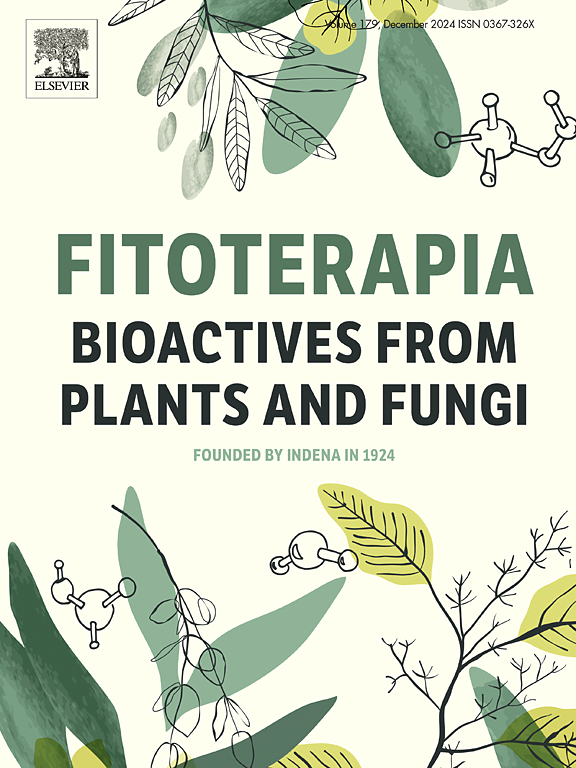Mechanistic analysis of Inonotus hispidus in ameliorating T2DM: Metabolomics and gut microbiota profiling in mice models
IF 2.6
3区 医学
Q3 CHEMISTRY, MEDICINAL
引用次数: 0
Abstract
As a large medicinal fungus, Inonotus hispidus (I. hispidus) has multiple pharmacological effects such as antioxidation, anti-inflammation, and hypoglycemia. However, studies on improving type 2 diabetes mellitus (T2DM) by the secondary metabolites of I. hispidus are still insufficient. In this study, we constructed HepG2-IR, HepG2-NAFLD cell models and a high-fat diet combined with streptozotocin-induced T2DM mice model. Using untargeted metabolomics, 16S rRNA gene sequencing of the gut microbiota, and Q Exactive UPLC-MS/MS analysis, we identified the active components of the I. hispidus ethanol extract (IHE) and elucidated its mechanisms against T2DM. The results showed that I. hispidus exerted hypoglycemic and hypolipidemic effects, and significantly reduced the serum levels of TC, TG, AST, and ALT in T2DM model mice. IHE enhanced antioxidant enzyme activities and reduced serum levels of inflammatory cytokines (IL-6, TNF-α). Mechanistically, it inhibited the TNF-α/NF-κB signaling pathway. Metabolomics combined with 16S amplicon sequencing analysis revealed that I. hispidus can increase the levels of metabolites such as naringenin chalcone and genistein, which have hypoglycemic and anti-inflammatory effects. Furthermore, these differential metabolites were significantly correlated with the increased abundance of Akkermansia and Bacteroides, as well as the decreased abundance of harmful bacterial genera such as Blautia and Desulfovibrio. In addition, 66 compounds were characterized in I. hispidus, with polyphenols being the main chemical constituents exerting therapeutic effects. This study provides an experimental basis for the multi-pathway improvement of T2DM by I. hispidus.

棘豆改善T2DM的机制分析:小鼠模型的代谢组学和肠道微生物群分析。
作为一种大型药用真菌,褐皮菌(Inonotus hispidus)具有抗氧化、抗炎、降血糖等多种药理作用。然而,关于棘豆次生代谢产物对2型糖尿病(T2DM)改善作用的研究仍然不足。在本研究中,我们构建了HepG2-IR、HepG2-NAFLD细胞模型和高脂肪饮食联合链脲佐菌素诱导的T2DM小鼠模型。利用非靶向代谢组学、肠道微生物群16S rRNA基因测序和Q Exactive UPLC-MS/MS分析,我们鉴定了海棘草乙醇提取物(IHE)的有效成分,并阐明了其抗2型糖尿病的机制。结果显示,海鞘有降糖降血脂作用,能显著降低T2DM模型小鼠血清TC、TG、AST、ALT水平。IHE提高抗氧化酶活性,降低血清炎症因子(IL-6、TNF-α)水平。机制上,它抑制TNF-α/NF-κB信号通路。代谢组学结合16S扩增子测序分析发现,海皮草能提高柚皮素查尔酮和染料木素等代谢产物的水平,具有降糖和抗炎作用。此外,这些差异代谢物与Akkermansia和Bacteroides的丰度增加以及Blautia和Desulfovibrio等有害细菌属的丰度降低显著相关。此外,海鞘中还鉴定出66种化合物,其中发挥治疗作用的主要化学成分为多酚。本研究为棘豆多途径改善T2DM提供了实验依据。
本文章由计算机程序翻译,如有差异,请以英文原文为准。
求助全文
约1分钟内获得全文
求助全文
来源期刊

Fitoterapia
医学-药学
CiteScore
5.80
自引率
2.90%
发文量
198
审稿时长
1.5 months
期刊介绍:
Fitoterapia is a Journal dedicated to medicinal plants and to bioactive natural products of plant origin. It publishes original contributions in seven major areas:
1. Characterization of active ingredients of medicinal plants
2. Development of standardization method for bioactive plant extracts and natural products
3. Identification of bioactivity in plant extracts
4. Identification of targets and mechanism of activity of plant extracts
5. Production and genomic characterization of medicinal plants biomass
6. Chemistry and biochemistry of bioactive natural products of plant origin
7. Critical reviews of the historical, clinical and legal status of medicinal plants, and accounts on topical issues.
 求助内容:
求助内容: 应助结果提醒方式:
应助结果提醒方式:


